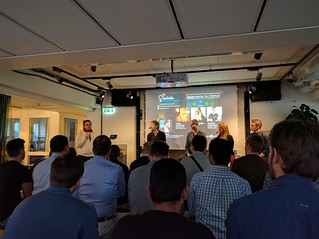So, the course is about to end. The content was quite fun and got to learn several important things in an entrepreneur’s world. One of the course assignments was the group formation and together work on a venture project.
We all pitched different and/or similar ideas in the beginning of the course and within our formed group we later discussed that the idea “Programming for Kids” was a hot subject and could be interesting to work with.
What was the reason we picked that idea? Well, we all were familiar with programming more or less because we study ICT in Kista and have been involved with several programming courses. Programming is a complete world of its own, the thinking, the designing, the trial&error and the result of solutions etc, only the imagination is the limit what is possible to do.
But we got to think, why is programming taught mostly in universities and some high schools? Of course, some people get introduced to it like a hobby or by friends/relatives but what if it could be taught in earlier school age or by some modern medium which kids use. We knew that some schools lend iPads to kids and many of them also have their own smartphone and/or tablet. That could be a great way of reaching out to them.
After a while in the course we got to discuss with our teacher Serdar who pointed out that we must try to reach to the customers first of all before even having a clear idea in mind what the end product would be. Well pointed out, but now we must figure out what questions to ask if we do get in touch with a class relevant to our target customer age.
We knew that it would be difficult to just storm into an elementary school to see if we can ask questions about our project, and also it wouldn’t look great, storming in unannounced. Lucky for us, we got in contact with a mentor of a class of the school “Matteusskolan” where my nephew went to. That mentor looked forward of us coming and visit them, which was a great opportunity to communicate directly with our potential customers. We set up a meeting with them and got half an hour of their time to retrieve as much feedback as possible.
Questions like:
- Does anyone know any IT-company? What these companies do?
- Does anyone know what programming is?
- What you can do with programming?
- Would you like to learn programming in some way?
We tried to ask open questions so they could really answer how they wanted and not answering like we want. And also tried to ease into our idea to see if they would be interested in learning programming.
This was a class of pupils in ages ~15 so we didn’t know what to expect for answers to our questions. Only one answered to the question what programming was, “like you build a program which does something” and not one knew how to do programming or had run into it just even a little bit. To those questions we explained some simple stuff you could do, like spinning a simple wheel by your phone if it was connected to Bluetooth.
To the questions more related to our idea, they seemed to like it very much and suggested several things how to make it come true, from the aspect of being able to have it as a subject in school to other aspects like detailed how it would work and what was actually the product they would be integrating with. We knew that we had to connect with them by targeting references they knew, so we explained more practical things that could be a possible learning platform such as programming robots with their actual smartphones. We drew on their whiteboard some simple concepts of programming and they understood that since we explained it in a way we thought they understand, and not according to our standard way of learning.
The most important reference we used which they also seemed to understand the whole product as, was that the product isn’t designed to just learn them, it is designed to be fun like a game. If we want them to learn programming we must make it fun to learn and games is a great channel to reach kids. When we left, we saw how eager they were to learn/play with programming since they asked when we could publish this project and if we could come back and show them the finished product.
Before this meeting and when we brainstormed ideas, we weren’t sure how the end product would be like. We had some concepts but it changed a bit and became clearer after the visit.
There are companies which have many products like this. They differ all the way from just being a platform on a tablet or computer to just a hardware based or a board game without any digital influence at all.
Tynker provide already control of robots and much more.
http://venturebeat.com/2014/06/03/12-games-that-teach-kids-to-code/view-all/
On venturebeat, they list several different variants of teaching kids to program. These products reach on different mediums such as web browsers on the computer and apps to iPads/iPhones. The prices differs from product to product but it is clear that the companies do have similar ways of making a profitable product, like in-app-purchases or demo&premium versions.
We understand that programming is an important subject which need to reach out to more people all the time. Nowadays E-sport is almost as popular as every other sport and that area of game-programming is as well as other areas of programming becoming more and more popular. EA’s CEO states in this article that game industry is growing even more.



